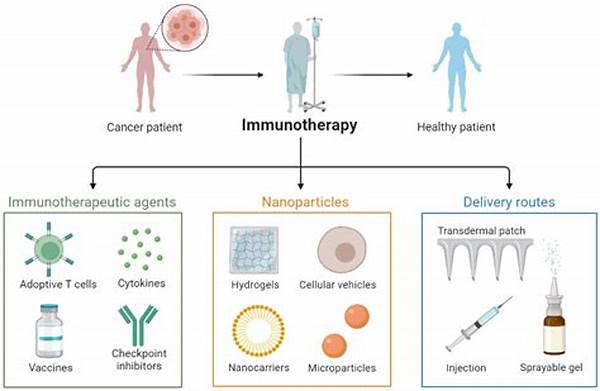Cancer remains one of the most formidable challenges in modern medicine, necessitating innovative approaches for effective treatment. One such promising advancement in oncological therapeutics is the development of smart nanocarriers for cancer targeting. These nanocarriers are engineered to selectively deliver therapeutic agents directly to cancer cells, thereby maximizing efficacy while minimizing adverse effects on healthy tissues. This article explores the nuances and potential of smart nanocarriers for cancer targeting, delving into recent advances and their applications.
Read Now : Developments In Regenerative Cell Technology
Advancements in Nanotechnology
The progression of nanotechnology has paved the way for groundbreaking innovations in medicine, particularly in the realm of cancer treatment. Smart nanocarriers for cancer targeting represent the pinnacle of these advancements, offering a sophisticated method of drug delivery. By utilizing the unique properties inherent to nanoparticles, such as enhanced permeability and retention effect, these carriers can infiltrate tumors more effectively than traditional methods. Recent research has highlighted their ability to be modified for stimuli-responsive release, ensuring that therapeutic agents are released precisely in the tumor microenvironment. The capacity of smart nanocarriers for cancer targeting to be functionalized with ligands that recognize cancer-specific markers further exemplifies their precision in targeting malignant cells, offering hope for more personalized and effective cancer treatments.
Mechanisms of Action
Smart nanocarriers for cancer targeting employ various mechanisms to achieve their goal:
1. Enhanced Permeability: Their nanoscale size allows these carriers to penetrate tumor vasculature easily.
2. Targeted Delivery: Ligands can be attached to recognize specific cancer markers.
3. Stimuli-Responsive Release: They release drugs in response to stimuli like pH or temperature differences.
4. Controlled Release: Enables consistent delivery rates over extended periods.
5. Reduced Toxicity: Minimizes effects on healthy tissues, reducing side effects.
Challenges and Future Directions
Despite the promising potential of smart nanocarriers for cancer targeting, several challenges remain. Significant efforts are required to overcome biological barriers that impede effective drug delivery and to ensure the stability and bioavailability of nanocarriers. Furthermore, large-scale production poses logistical and economic challenges that must be addressed to make these therapies accessible. The ongoing research endeavors focus on optimizing the design and functionality of these nanocarriers, improving their targeting capabilities, and ensuring their safety for clinical applications. The vision for the future is to integrate smart nanocarriers for cancer targeting with other treatment modalities, such as immunotherapy, to achieve synergistic effects and ultimately enhance patient outcomes.
Real-World Applications of Smart Nanocarriers
Smart nanocarriers for cancer targeting are undeniably making waves, and here’s the lowdown on their impressive game plan:
1. Target Precision: With pinpoint accuracy, these nanocarriers hit cancer cells, outperforming traditional treatments.
Read Now : Sustainable Herbal Medicine Approaches
2. Minimal Side Effects: By sparing healthy tissue, they reduce those annoying side effects.
3. Next-Level Release: They unleash drugs when conditions are just right, thanks to their smart design.
4. Onward and Upward: With advancements in this tech, the domain of cancer treatment is set for transformation.
5. Fusion with Innovations: Pairing these carriers with emerging therapies could spell game over for cancer.
Clinical Potential and Efficacy
Scientific Validation
Smart nanocarriers for cancer targeting have garnered considerable attention in clinical research due to their potential to revolutionize cancer treatment modalities. Numerous pre-clinical and clinical studies underscore the marked efficacy of these nanocarriers in enhancing the bioavailability of therapeutic agents at tumor sites. By refining the selectivity and delivery efficiency of anticancer drugs, smart nanocarriers can markedly reduce the dosage required, thus diminishing the risk of systemic toxicity. This represents a formidable stride toward achieving improved therapeutic outcomes and aligns with the broader objective of personalized medicine.
Future Prospects
Looking to the future, the integration of smart nanocarriers for cancer targeting into mainstream medical practice holds great promise. Continuous research is directed toward enhancing their responsiveness to a variety of internal and external stimuli, thereby refining their deployment in diverse oncological contexts. The convergence of nanotechnology with genomic insights into cancer biology is set to further amplify the efficacy of these carriers, fostering groundbreaking strides in targeted cancer therapies. Moreover, addressing the challenges related to production scalability and regulatory compliance will be imperative in realizing the full potential of smart nanocarriers for cancer targeting, paving the way for their widespread clinical adoption.
Summary and Conclusions
Evolving Paradigms
The advent of smart nanocarriers for cancer targeting is emblematic of the evolving paradigms in oncological therapeutics. These carriers offer unprecedented precision in targeting and delivering chemotherapeutic agents, thereby transforming the landscape of cancer treatment. As the field progresses, continued innovation and interdisciplinary collaboration will be pivotal in overcoming existing limitations and unlocking new dimensions in targeted cancer therapy.
Promising Horizon
The journey toward mainstreaming smart nanocarriers for cancer targeting in clinical settings is underway, promising substantial implications for patient care. The progress made thus far is a testament to their potential in enhancing treatment efficacy while minimizing collateral damage to healthy tissues. In essence, these technological advances herald a new dawn in the fight against cancer, offering renewed hope for patients and medical practitioners alike in their relentless quest toward conquering this formidable disease.
